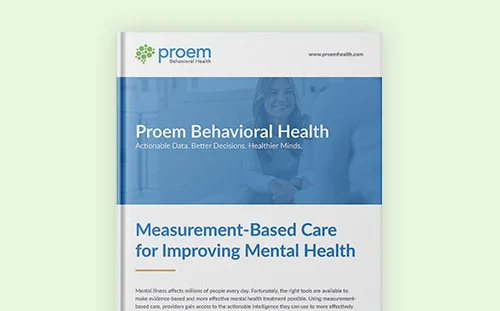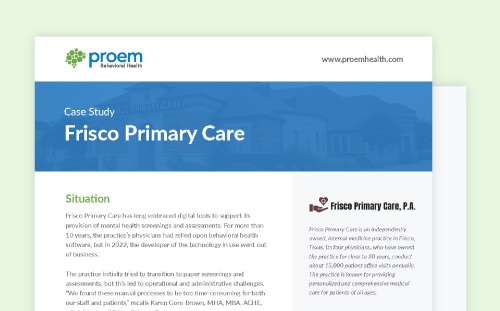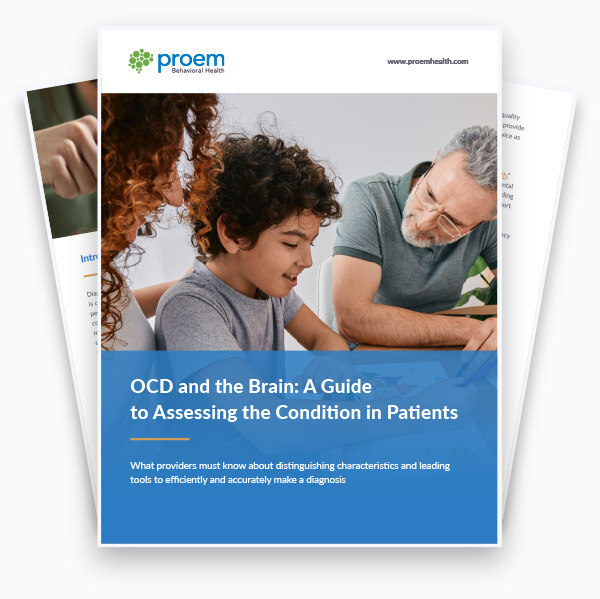OCD and the Brain: A Guide to Assessing the Condition in Patients
Diagnosing any mental health condition is complicated. Subjective analysis, personal experience, and symptoms that could be attributed to many disorders make assessments and diagnoses hard enough. Mainstream misunderstanding and simplification of Obsessive Compulsive Disorder (OCD), however, has made providers’ jobs even harder.
Understanding OCD and the brain is far more complex than many people realize, and symptoms can become severe. In this guide, we’ll break through the misinformation and mystery surrounding the disorder to give you a firm foundation in the various types of OCD, the challenges patients face, the most used diagnostic tools and how we arrived at advanced assessments.
Table of Contents

Chapter 1:
The Types of OCD and Intricacies of Identification and Treatment
People with OCD have unwanted recurring thoughts (obsessions), and the condition is marked by repetitive behaviors or mental acts (compulsions) – all of which can considerably interrupt patients’ day-to-day lives. Although OCD may be confused with Obsessive-Compulsive Personality Disorder (OCPD) or general anxiety, there are distinct differences.
Individuals experiencing OCPD are chronically preoccupied with rules, orderliness, and control – but, unlike those with different types of OCD, individuals with OCPD often see their behaviors as rational and beneficial. Anxiety disorders and OCD may manifest similarly but have unique patterns of obsessions and compulsions.
Myths and stigmas surrounding OCD and the brain, especially misconceptions that OCD is simply being 'overly neat' or 'perfectionistic,' trivialize the impact OCD can have on a person's life and may prevent individuals from seeing the problem and seeking professional help, exacerbating their condition.
The 4 Primary Types of OCD
There are four distinct categorizations of OCD, each with specific challenges:
1 Checking
What it involves: Constantly checking things like locks or appliances to prevent perceived harm.
Clinical presentations:
-
Safety-Related Checking – checking possible hazards like emergency exits and smoke detectors.
-
Digital Checking – compulsively checking digital communications for errors or inappropriate content.
-
Memory-Based Checking – spending hours reliving interactions to uncover mistakes or unintended harm.
-
Physical/Medical Checking – excessively monitoring vital signs, breathing patterns or body sensations, frequently resulting in unnecessary medical visits.
-
Documentation Checking – repeatedly reviewing important documents, which lowers productivity.
2 Contamination OCD
What it involves: An intense fear of germs, dirt or toxins, leading to excessive cleaning or avoidance behaviors.
Common feelings and experiences:
-
Environmental Contamination Fears – avoidance of places or technologies over concerns about asbestos, radiation or electromagnetic fields.
-
Body-Focused Contamination – obsessing over bodily processes and cleaning so vigorously that it hurts the person physically or socially.
-
Emotional Contamination – fear of "absorbing" others’ negative emotions or characteristics.
-
Chemical Sensitivity – restrictions on diet or living space due to extreme reactions to everyday products.
3 Symmetry and Ordering
What it involves: A compulsion to arrange items symmetrically or in a specific order. Individuals may have a desire to alleviate discomfort or prevent perceived disaster.
Patterns common in this type of OCD and the brain:
-
Mathematical Symmetry – objects must be arranged in specific numerical patterns.
-
Visual Balance – items must be visually aligned from multiple angles.
-
Time-Based Ordering – activities are done in exact time intervals.
-
Sensory Symmetry – the same physical sensations are needed on both sides of the body.
-
Color-Based Arrangements – items must be organized by specific color patterns.
4 Intrusive Thoughts
What it involves: Persistent, distressing thoughts that may be violent, sexual or blasphemous. The individual may use mental rituals to mitigate anxiety.
Manifestations:
-
Moral Scrupulosity – obsessing over moral righteousness and ethical perfection.
-
Religious Scrupulosity – intrusive thoughts about blasphemy or religious inadequacy.
-
Relationship OCD – frequent doubts about partner compatibility.
-
Harm OCD – intrusive thoughts about causing harm, with no intention to do so.
-
Existential OCD – obsessive thoughts about reality, existence and consciousness.
Diagnosing OCD in Children vs. Adults
OCD in children can be more difficult to diagnosis than in adults because kids might not recognize the severity of their obsessions and compulsions. The first signs may be secondary effects of OCD like behavioral problems or academic difficulties.
Though they’re more likely to be aware of their symptoms, adults may not seek help due to shame and stigma. Providers can use OCD assessment tools like the Children's Yale-Brown Obsessive-Compulsive Scale II (CY-BOCS II) to assess OCD in children and the YBOCS-II for adults.
Care and Treatment for all Types of OCD
While mental health providers have specialized knowledge about OCD and the brain, primary care providers (PCPs) are key to identifying and managing the condition. They play critical roles in early detection, such as screening for family history and risk factors; care coordination, including referrals to mental health providers and management of co-morbidities; and patient education and support, which can address OCD misconceptions and help ensure care plan adherence.
Cognitive-behavioral therapy (CBT), especially Exposure and Response Prevention (ERP), is the leading treatment for OCD. Medication like selective serotonin reuptake inhibitors (SSRIs) can help as well. Beyond medical care, positive environmental and lifestyle changes can ease OCD symptoms by reducing stressors, and mobile symptom-tracking apps and virtual therapy can increase accessibility to monitoring and care.

Chapter 2:
Examining OCD Assessments: YBOCS-II and FOCI
OCD assessment and screening tools are vital for PCPs and mental health professionals alike. They help providers align symptoms and diagnoses, identify manifestations like OCD and perfectionism or OCD and rumination, measure severity, and monitor treatment journeys.
Why Comprehensive OCD Assessment Is Necessary in Primary Care
Symptom overlap between mental health conditions can make understanding OCD and the brain challenging, particularly for primary care providers, so accurate and comprehensive OCD assessment and diagnostics are crucial for identifying specific obsessions and compulsions, enabling personalized interventions, and developing effective care plans.
OCD assessment tools are also a key source of information for insurance authorization, and they provide documentation of specific symptom patterns and symptom tracking to improve treatment.
Let's explore the two most widely-used OCD assessment tools.
A Closer Look at YBOCS-II
The Yale-Brown Obsessive Compulsive Scale-Second Edition, or YBOCS-II, is intended to provide a thorough overview of an OCD patient’s obsessive and compulsive behaviors. It evaluates the severity and types of symptoms experienced by individuals with OCD using a checklist of common obsessions and compulsions and a scale that assesses the impact of these symptoms on the patient's daily life. It takes approximately 30 minutes to complete and has a high level of consistency and good test-retest reliability.
For younger patients, the Children's Yale-Brown Obsessive Compulsive Scale-Second Edition, or CYBOCS-II, has a similar structure and purpose but is tailored for their needs.
It takes approximately
30 min
to complete YBOCS-II
Understanding FOCI
The Florida Obsessive Compulsive Inventory (FOCI) is brief and easy to use – it’s perfect for busy primary care providers needing quick insights into OCD and the brain, and, because it only takes around 10 minutes, it’s ideal for initial screenings. The FOCI identifies the presence and severity of OCD symptoms and has a more streamlined symptom checklist and severity scale than the YBOCS-II.
It takes approximately
10 min
to complete FOCI
The FOCI severity scale ranges from 0 to 20 (smaller than the YBOCS-II's 0-40 range), with higher scores indicating greater symptom severity. It has high internal consistency and good validity.
The Children's Florida Obsessive Compulsive Inventory (C-FOCI) assesses OCD in children.
Comparing YBOCS-II and FOCI: Pros and Cons
Though both OCD assessment tools are excellent, they each have advantages and limitations. The YBOCS-II is ideal for in-depth assessments and treatment planning but might take too long in primary care settings. The FOCI is faster to administer but may not produce the level of information the YBOCS-II can. Choosing the right option can therefore depend on the patient's unique needs and the clinical setting.
Why Early Detection Is Imperative for Better Outcomes
Detecting OCD in its early stages can help improve patient outcomes by:
-
Preventing symptom escalation, which can ease the severity of the condition, lower the risk of developing other conditions like depression and anxiety, and help prevent academic, occupational and social impairment;
-
Positively impacting quality of life, because earlier treatment leads to fewer disruptions to daily functioning, precludes OCD patterns, and helps the person maintain better relationships and performance at school or work; and
-
Making treatment more cost-effective, by lowering the likelihood of intensive interventions or hospitalization and minimizing possible disability claims.

Chapter 3:
The Evolution of OCD Screening: From Stigma to Science-Based Scale
You can’t comprehend the complexity of OCD and the brain without first acknowledging the history of OCD screening and diagnosis and the evolution of evidence-based assessment tools that have clarified how the condition manifests and the various symptoms it encompasses. This groundwork has not only contributed to destigmatization of OCD, but also opened new avenues for more effective, targeted treatment by giving providers insights that can help them more deeply explore the motivations and thought patterns underlying obsessive-compulsive behaviors.
Early Understanding and Challenges
Early OCD screening was hampered by misconceptions about the condition. Misdiagnoses or delayed diagnosis and treatment were common due to stigma or provider confusion over symptoms, like impulsive vs intrusive thoughts.
Early OCD screening and diagnosis tests were revolutionary but not mature enough to capture all OCD presentations.
The YBOCS Revolution
In the late 1980s, the comprehensive assessment tool YBOCS changed the game and became the gold standard for OCD screening questions and symptom assessment. For the first time, clinicians had a structured approach to evaluating OCD and the brain.
YBOCS-II Arrives and Elevates Screening and Diagnosis
The transition from this first model, YBOCS-I, to its successor YBOCS-II then brought several improvements, including:
1 More Symptom Categories and a Dimensional Approach
YBOCS-II introduced six new symptom dimensions, each with separate severity ratings for more targeted treatment: Aggressive/Sexual/Religious; Symmetry; Contamination; Hoarding; Miscellaneous; and Somatic. The tool also better recognizes symptom heterogeneity across patient populations.
2 A Refined Severity Scale
The second edition of YBOCS is more precise, wielding a 0-5 rating scale (vs. the prior 0-4 scale) and detecting more subtle clinical changes. It has better-defined anchor points for severity ratings, avoidance assessment in severity scoring, and can differentiate more clearly between obsession and compulsion severity.
3 Enhanced Assessment of Insight
YBOCS-II is more sophisticated in how it evaluates OCD and the brain, able to differentiate between poor patient insight and delusional beliefs. It also aligns more closely with Diagnostic and Statistical Manual of Mental Disorders (DSM) criteria.
4 Time Management Improvements
Providers using YBOCS-II save time with a more organized symptom checklist, better flow between assessment sections, and a simplified scoring system. But, despite enjoying these enhancements and a 30% faster completion rate, they’re still able to arrive at a more thorough evaluation.
5 Clinical Utility Augmentation
More sophisticated evaluation meets more refined treatment with YBOCS-II. Providers can better personalize their understanding of OCD patients with functional impairment assessment as well as improved assessment of mental rituals and covert compulsions. Avoidance behaviors are also documented in more detail, and YBOCS-II integrates better with treatment planning and is better able to track patient response.
6 Research Applications
YBOCS-II also ensures the efficacy and dependability of OCD research by standardizing symptom categorization, reducing bias in cross-cultural OCD studies, contributing to the accuracy of clinical trials, and more accurately capturing changes in symptom severity after treatment.
YBOCS-II-SR: The Benefits of Self-Reporting
Another major advancement in OCD screening, the YBOCS-II Self-Report version (YBOCS-II-SR), allows patients to complete initial OCD screening at their own pace. In addition to combatting stigma around the condition by engaging the patient in their care, it prevents the anxiety of in-person assessment and enables patients to prepare to discuss their symptoms.
Because it supplies data to the provider before an appointment, YBOCS-II-SR optimizes the time patients and providers spend working together. It also eases the administrative burden.
In addition to being dependable for initial diagnosis, the self-reporting tool is also trusted for symptom monitoring, research shows. Studies reveal high concordance with clinician-administered assessments, especially around:
-
Symptom identification
-
Severity assessment
-
Treatment response monitoring
-
Dimensional scoring
Because it can differentiate between impulsive vs intrusive thoughts, YBOCS-II-SR is particularly valuable to PCPs, who can use it to make better-informed decisions about mental health provider referrals and treatment planning.

Conclusion:
The Ideal Way to Implement OCD Screening and Diagnostic Tools
Medical understanding of OCD and the brain and the related OCD screening and diagnosis tools have come a long way. PCPs are armed with better knowledge and resources for initial assessment, while behavioral health specialists are better able to monitor treatment progress and outcomes.
Digital platforms have transformed the way OCD screening tools are implemented, and Proem Behavioral Health is the exclusive digital licensee for many of them, including all versions of the YBOCS and FOCI. Our clinical workflow software offers:
-
Refined administration of validated screening tools
-
Integration with existing workflows
-
Comprehensive reporting
-
Evidence-based decision support
To see how Proem can help you accurately and efficiently screen for and diagnose OCD, book a demo today.









